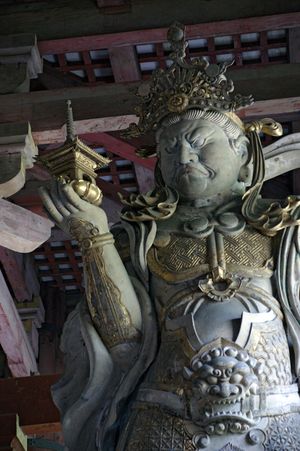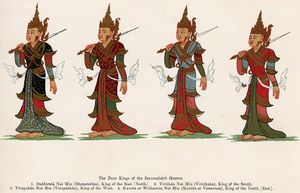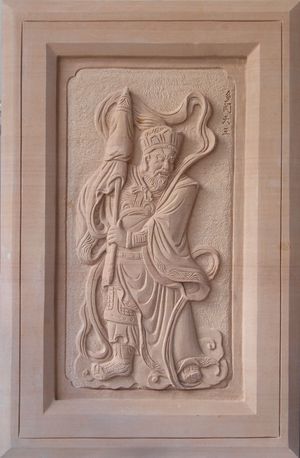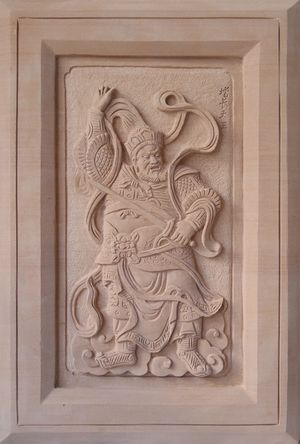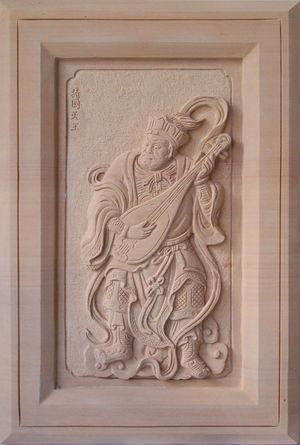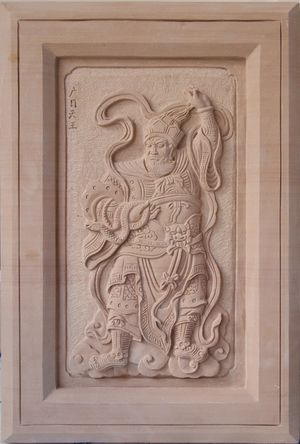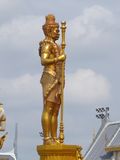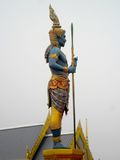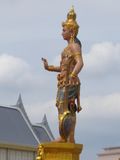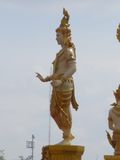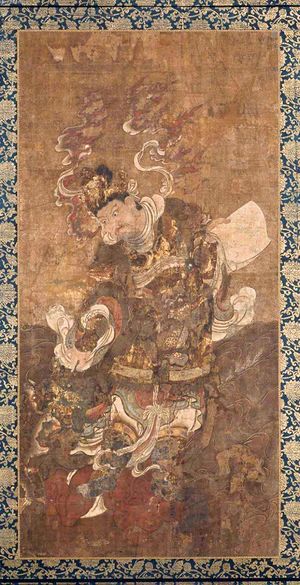الملوك السماويون الأربع
الملوك السماويون الأربع Four Heavenly Kings هم أربع آلهة بوذية، كل منهم يراقب أحد الجهات الأربع للعالم. في الأساطير الصينية، يُعرفون جَمعاً بإسم "فنگ تياو يو شون" (الصينية المبسطة: 风调雨顺؛ الصينية التقليدية: 風調雨順؛ حرفياً: 'الطقس الجميل'�) أو "سي دا تيانوانگ" (صينية: 四大天王؛ حرفياً: 'الملوك السماويون الأربع العظام'�). وفي اللغة السنسكريتية القديمة، يُسَمَّون "كاتورمهراجا" (चतुर्महाराज)، أو "كاتورمهراجيكادِڤا": "الملوك السماويون الأربع العظام". قاعة الملوك السماويين هي أحد المكونات القياسية في المعابد البوذية الصينية.
. . . . . . . . . . . . . . . . . . . . . . . . . . . . . . . . . . . . . . . . . . . . . . . . . . . . . . . . . . . . . . . . . . . . . . . . . . . . . . . . . . . . . . . . . . . . . . . . . . . . . . . . . . . . . . . . . . . . . . . . . . . . . . . . . . . . . . . . . . . . . . . . . . . . . . . . . . . . . . . . . . . . . . . .
الأسماء
The Kings are collectively named as follows:
| اللغة | الصيغة المكتوبة | الرَومنة | الترجمة |
|---|---|---|---|
| السنسكريتية | चतुर्महाराज | Caturmahārāja Chaturmahārājikā |
Four Great Kings |
| (लोकपाल | Lokapāla | Guardians of the World | |
| Sinhalese | සතරවරම් දෙවිවරු | Satharawaram Dewi | Four Privileged/Bestowed Gods |
| Burmese | စတုလောကပါလ စတုမဟာရာဇ်နတ် |
IPA: [sətṵ lɔ́ka̰ pàla̰] IPA: [sətṵ məhà ɹɪʔ naʔ] |
Loanword from catulokapāla loanword from catumahā + king nats |
| Chinese | 天王 | Tiānwáng | Heavenly Kings |
| 四天王 | Sì Tiānwáng | Four Heavenly Kings | |
| 四大天王 | Sì Dà Tiānwáng | Four Great Heavenly Kings | |
| Korean | 天王/천왕 | Cheonwang | Heavenly kings |
| 四天王/사천왕 | Sacheonwang | Four heavenly kings | |
| 四大天王/사대천왕 | Sadae Cheonwang | Four great heavenly kings | |
| Japanese | 四天王 | Shitennō | Four heavenly kings |
| Vietnamese | 四天王 | Tứ Thiên Vương | Four heavenly kings |
| Tibetan | རྒྱལ༌ཆེན༌བཞི༌ | rgyal chen bzhi | Four great kings |
| Mongolian | ᠳᠥᠷᠪᠡ ᠮᠠᠬᠠᠷᠠᠨᠵᠠ Тэнгэрийн дөрвөн хаан |
Tengeriin dörwön xaan | Four kings of the sky |
| Thai | จาตุมหาราชา | Chatumaharacha | Four Great Kings, loan word from catumahārāja (Pali) |
| จตุโลกบาล | Chatulokkaban | Four Guardians of the World, loan word from catulokapāla (Pali) |
The Four Heavenly Kings are said to currently live in the Cāturmahārājika heaven (Pali Cātummahārājika, "Of the Four Great Kings") on the lower slopes of Mount Sumeru, which is the lowest of the six worlds of the devas of the Kāmadhātu. They are the protectors of the world and fighters of evil, each able to command a legion of supernatural creatures to protect the Dharma.
| devanagari Sanskrit romanization |
वैश्रवण (कुबेर) Vaiśravaṇa (Kubera) |
विरूढक Virūḍhaka |
धृतराष्ट्र Dhṛtarāṣṭra |
विरूपाक्ष Virūpākṣa |
| Meaning | he who hears everything | he who causes to grow | he who upholds the realm | he who sees all |
| Description | This is the chief of the four kings and protector of the north. He is the ruler of rain. His symbolic weapons are the umbrella or pagoda. Wearing heavy armor and carrying the umbrella in his right hand, he is often associated with the ancient Indian God of wealth, Kubera. Associated with the color yellow or green. | King of the south and one who causes good growth of roots. He is the ruler of the wind. His symbolic weapon is the sword which he carries in his right hand to protect the Dharma and the southern continent. Associated with the color blue. | King of the east and God of music. His symbolic weapon is the pipa (stringed instrument). He is harmonious and compassionate and protects all beings. Uses his music to convert others to Buddhism. Associated with the color white. | King of the west and one who sees all. His symbolic weapon is a snake or red cord that is representative of a dragon. As the eye in the sky, he sees people who do not believe in Buddhism and converts them. His ancient name means "he who has broad objectives". Associated with the color red. |
| Color | yellow or green | blue | white | red |
| Symbol | umbrella | sword | pipa | serpent |
| mongoose | stupa | |||
| stupa | pearl | |||
| Followers | yakṣas | kumbhāṇḍas | gandharvas | nāgas |
| Direction | north | south | east | west |
| Traditional/Simplified Chinese Pinyin |
多聞天王 / 多闻天王 Duō Wén Tiānwáng |
增長天王 / 增长天王 Zēng Zhǎng Tiānwáng |
持國天王 / 持国天王 Chí Guó Tiānwáng |
廣目天王 / 广目天王 Guăng Mù Tiānwáng |
| 毗沙門天 / 毗沙门天 | 留博叉天 / 留博叉天 | 多羅吒天 / 多罗吒天 | 毗琉璃天 / 毗琉璃天 | |
| Kanji Hepburn romanization |
多聞天 (毘沙門天) Tamon-ten (Bishamon-ten) |
増長天 Zōchō-ten |
持国天 Jikoku-ten |
広目天 Kōmoku-ten |
| 治国天 Jikoku-ten | ||||
| Hangul Hanja romanized Korean |
다문천왕 多聞天王 Damun-cheonwang |
증장천왕 增長天王 Jeungjang-cheonwang |
지국천왕 持國天王 Jiguk-cheonwang |
광목천왕 廣目天王 Gwangmok-cheonwang |
| Sino-Vietnamese | Đa Văn Thiên | Tăng Trưởng Thiên | Trì Quốc Thiên | Quảng Mục Thiên |
| Tibetan alphabet and romanization | རྣམ་ཐོས་སྲས་ (Namthöse) | ཕགས་སྐྱེས་པོ་ (Phakyepo) | ཡུལ་འཁོར་སྲུང་ (Yülkhorsung) | སྤྱན་མི་བཟང་ (Chenmizang) |
- Four Heavenly Kings statues at the royal crematorium of King Bhumibol Adulyadej of Thailand
Mythology
All four Kings serve Śakra, the lord of the devas of Trāyastriṃśa. On the 8th, 14th and 15th days of each lunar month, the Kings either send out emissaries or go themselves to inspect the state of virtue and morality in the world of men. Then they report their findings to the assembly of the Trāyastriṃśa devas.
On the orders of Śakra, the Kings and their retinues stand guard to protect Trāyastriṃśa from another attack by the Asuras, which once threatened to destroy the realm of the devas. They also vowed to protect the Buddha, the Dharma, and the Buddha's followers from danger.
According to Vasubandhu, devas born in the Cāturmahārājika heaven are 1/4 of a krośa in height (about 750 feet tall). They have a five-hundred-year lifespan, of which each day is equivalent to 50 years in our world; thus their total lifespan amounts to about nine million years (other sources say 90,000 years).
The attributes borne by each King also link them to their followers; for instance, the nāgas, magical creatures who can change form between human and serpent, are led by Virūpākṣa, represented by a snake; the gandharvas are celestial musicians, led by Dhṛtarāṣṭra, represented with a lute. The umbrella was a symbol of regal sovereignty in ancient India, and the sword is a symbol of martial prowess. Vaiśravaṇa's mongoose, which ejects jewels from its mouth, is said to represent generosity in opposition to greed.
| Tamon-ten
(north) |
||
| Kōmoku-ten
(west) |
Heavenly Kings (Japanese) |
Jikoku-ten
(east) |
| Zōjō-ten
(south) |
في الثقافة الشعبية
- The Spice Boys are a collective of antagonists called 魔族四天王 (Mazoku Shitennō, lit. Four Heavenly Kings of the Demon Clan) in the anime Dragonball Z.
- The Elite Four from the Pokémon franchise are known as the Four Heavenly Kings in the original Japanese.
- The Four Guardians from the video game series Mega Man Zero are known as the Four Heavenly Kings in the original Japanese.
- The Four Kings of Heaven (or Negacommanders in the original English dub) is the collective name of four antagonists in the Sailor Moon franchise.
- The Four Heavenly Kings is an association of aliens in Ultraman Mebius.
- The Four Heavenly Kings of Orochi from The King of Fighters video game series.
- The Four Heavenly Kings is a group of four powerful "Gourmet Hunters" in the anime/manga Toriko.
- The Elite Four from the anime Kill la Kill are known as the Four Heavenly Kings in the original Japanese.
- The Four Heavenly Kings of Shadaloo from Street Fighter However Sagat is later replaced by Fang in Street Fighter V.
See also
- Guardians of the directions
- Bacab
- Lokapala
- Tetramorph
- Titan (mythology)
- Anemoi
- Four Dwarves (Norse Mythology)
- Four Stags (Norse Mythology)
الهامش
- Chaudhuri, Saroj Kumar. Hindu Gods and Goddesses in Japan. New Delhi: Vedams eBooks (P) Ltd., 2003. ISBN 81-7936-009-1.
- Nakamura, Hajime. Japan and Indian Asia: Their Cultural Relations in the Past and Present. Calcutta: Firma K.L. Mukhopadhyay, 1961. Pp. 1–31.
- Potter, Karl H., ed. The Encyclopedia of Indian Philosophies, volume 9. Delhi: Motilal Banarsidass, 1970–. ISBN 81-208-1968-3, ISBN 81-208-0307-8 (set).
- Thakur, Upendra. India and Japan: A Study in Interaction During 5th cent.–14th cent. A.D.. New Delhi: Abhinav Publications, 1992. ISBN 81-7017-289-6. Pp. 27–41.
وصلات خارجية
- Schumacher, Mark. "Shitenno - Four Heavenly Kings (Deva) of Buddhism, Guarding Four Cardinal Directions". Digital Dictionary of Buddhism in Japan.
- مقالات تحتوي نصوصاً باللغة الصينية المبسطة
- مقالات تحتوي نصوصاً باللغة الصينية التقليدية
- مقالات تحتوي نصوصاً باللغة الصينية
- Articles containing صينية-language text
- Articles containing كورية-language text
- Pages with empty portal template
- Buddhist cosmology
- أساطير صينية
- Journey to the West characters
- Lokapalas
- Quartets
